Integrating Entropy Weight and MaxEnt Models for Ecotourism Suitability Assessment in Northeast China Tiger and Leopard National Park
Abstract
:1. Introduction
2. Materials and Methods
2.1. Study Area
2.2. Methodological Overview
2.3. Data Preparation
2.3.1. Screening of Criteria
2.3.2. Dataset and Preprocessing
2.4. Entropy Weight Method
- Step 1:
- Assuming there are m evaluation objects and n evaluation criteria, the initial decision Matrix X is constructed as follows:where m is the number of raster cells in the data layer, n is the number of criteria for ecotourism suitability assessment, and denotes the value of the i-th raster cell on Criterion j.
- Step 2:
- Due to the different dimensions of criteria data, it is necessary to normalize the initial decision matrix. Since the criteria selected in this study have both positive and negative types (refer to Table 1), they require differentiated processing during normalization. The normalized decision matrix can be represented as follows:where represents the standardized value of the i-th raster cell on Criterion j, and .The normalization process for positive criteria is as follows:The normalization process for negative criteria is as follows:where is the minimum value of the i-th raster cell on Criterion j, and is the maximum value of the i-th raster cell on Criterion j.
- Step 3:
- Determine the Information Entropy of the evaluation criteria. The formula for weight entropy is as follows:where represents the entropy of Criterion j, and represents the proportion of the Value of the i-th raster cell to the total sum of all raster cell values for the same Criterion j.represents the relative importance of Indicator j in the i-th grid. When is unevenly distributed among different grids, a certain value is significantly larger than other values. Then, the corresponding to will be significantly larger than other (calculated by Equation (6)). Assuming that the corresponding to a certain is approximately 1 and that other are approximately 0, the Information Entropy will reach its minimum value approaching 0 (calculated by Equation (5)). This would indicate that the system’s disorder is low. When is evenly distributed among different grids, each will be approximately , and the Information Entropy will reach its maximum value, which is 1 (calculated by Equation (5)). This would indicate that the system’s disorder is high.
- Step 4:
- Determine the weight of evaluation Criterion j. The formula is as follows:where , and .
2.5. MaxEnt Model
2.6. Comprehensive Suitability Zoning Methodology
3. Results
3.1. Ecotourism Suitability Modeling
3.1.1. Weights from Entropy
3.1.2. Ecotourism Suitability Distribution
3.2. Tiger and Leopard Habitat Suitability Modeling
3.2.1. Model Performance
3.2.2. Variables Influencing Habitat Suitability
3.2.3. Habitat Suitability Distribution
3.3. Assessment of Comprehensive Ecotourism Suitability
4. Discussion
5. Conclusions
Author Contributions
Funding
Data Availability Statement
Acknowledgments
Conflicts of Interest
Appendix A
| Criteria | Mean | Standard Deviation |
|---|---|---|
| NDVI | 0.9323 | 0.0295 |
| Soil Erosion (t/(ha·y)) | 1.6660 | 1.6328 |
| Temperature (°C) | 3.9556 | 0.7866 |
| Precipitation (mm) | 193.2432 | 50.7853 |
| Distance to Rivers (m) | 8084.5665 | 5978.0179 |
| Elevation (m) | 623.2827 | 186.4150 |
| Slope (°) | 12.7402 | 7.1697 |
| Distance to Roads (m) | 3915.3919 | 3090.1823 |
| Distance to Villages (m) | 7339.2994 | 4041.9888 |
| Distance to Tourist Attractions (m) | 23,416.1303 | 14,227.1499 |
| Density of Wild Boars (individuals/km2) | 0.1532 | 0.0512 |
| Density of Roe Deer (individuals/km2) | 2.1979 | 0.6214 |
| Criteria | Category | Value | Reasons |
|---|---|---|---|
| Land Use Classes | Forest | 6 | Higher vegetation areas, like forests and grasslands, support biodiversity and offer essential resources. As a result, these areas benefit ecotourism and provide suitable habitats for Amur tigers and leopards. |
| Grassland | 5 | ||
| Wetland | 4 | ||
| Water | 3 | ||
| Cropland | 2 | ||
| Building | 1 | ||
| Aspect | South | 9 | South-facing slopes receive the most sunlight, promoting dense vegetation and suitable habitats. As sunlight decreases in other directions, vegetation diversity declines. Plane areas are ranked last due to their monotonous landscape, reducing ecotourism appeal and providing poor cover for tigers and leopards. |
| Southeast | 8 | ||
| Southwest | 7 | ||
| East | 6 | ||
| West | 5 | ||
| Northeast | 4 | ||
| Northwest | 3 | ||
| North | 2 | ||
| Plane | 1 |
References
- Ma, Z.; Chen, Y.; Melville, D.S.; Fan, J.; Liu, J.; Dong, J.; Tan, K.; Cheng, X.; Fuller, R.A.; Xiao, X.; et al. Changes in area and number of nature reserves in China. Conserv. Biol. 2019, 33, 1066–1075. [Google Scholar] [CrossRef] [PubMed]
- Gössling, S. Global environmental consequences of tourism. Glob. Environ. Change 2002, 12, 283–302. [Google Scholar] [CrossRef]
- Baloch, Q.B.; Shah, S.N.; Iqbal, N.; Sheeraz, M.; Asadullah, M.; Mahar, S.; Khan, A.U. Impact of tourism development upon environmental sustainability: A suggested framework for sustainable ecotourism. Environ. Sci. Pollut. Res. 2023, 30, 5917–5930. [Google Scholar] [CrossRef] [PubMed]
- Rawat, U.; Agarwal, N.K. Biodiversity: Concept, threats and conservation. Environ. Conserv. J. 2015, 16, 19–28. [Google Scholar] [CrossRef]
- Yuxi, Z.; Linsheng, Z.; Ling-en, W.; Hu, Y. Measuring the conflict tendency between tourism development and ecological protection in protected areas: A study on National Nature Reserves in China. Appl. Geogr. 2022, 142, 102690. [Google Scholar] [CrossRef]
- Diamantis, D. The concept of ecotourism: Evolution and trends. Curr. Issues Tour. 1999, 2, 93–122. [Google Scholar] [CrossRef]
- Jeong, E.; Lee, T.; Brown, A.D.; Choi, S.; Son, M. Does a national park enhance the environment-friendliness of tourists as an ecotourism destination? Int. J. Environ. Res. Public Health 2021, 18, 8321. [Google Scholar] [CrossRef] [PubMed]
- Stronza, A.; Pêgas, F. Ecotourism and conservation: Two cases from Brazil and Peru. Hum. Dimens. Wildl. 2008, 13, 263–279. [Google Scholar] [CrossRef]
- Stronza, A.L.; Hunt, C.A.; Fitzgerald, L.A. Ecotourism for conservation? Annu. Rev. Environ. Resour. 2019, 44, 229–253. [Google Scholar] [CrossRef]
- Shannon, G.; Larson, C.L.; Reed, S.E.; Crooks, K.R.; Angeloni, L.M. Ecological consequences of ecotourism for wildlife populations and communities. In Ecotourism’s Promise and Peril: A Biological Evaluation; Springer: Berlin/Heidelberg, Germany, 2017; pp. 29–46. [Google Scholar]
- Costa, T.d.O.; Assis, L.R.d.; Calijuri, M.L.; Assemany, P.P.; Lima, G.S. Defining priority zones for conservation and ecotourism in a protected area. Rev. Árvore 2016, 40, 769–779. [Google Scholar] [CrossRef]
- Thede, A.K.; Haider, W.; Rutherford, M.B. Zoning in national parks: Are Canadian zoning practices outdated? J. Sustain. Tour. 2014, 22, 626–645. [Google Scholar] [CrossRef]
- Mahdavi, A.; Niknejad, M. Site suitability evaluation for ecotourism using MCDM methods and GIS: Case study-Lorestan province, Iran. J. Biodivers. Environ. Sci. 2014, 4, 425–437. [Google Scholar]
- Mansour, S.; Al-Awhadi, T.; Al-Hatrushi, S. Geospatial based multi-criteria analysis for ecotourism land suitability using GIS & AHP: A case study of Masirah Island, Oman. J. Ecotour. 2020, 19, 148–167. [Google Scholar]
- Acharya, A.; Mondal, B.K.; Bhadra, T.; Abdelrahman, K.; Mishra, P.K.; Tiwari, A.; Das, R. Geospatial analysis of geo-ecotourism site suitability using AHP and GIS for sustainable and resilient tourism planning in West Bengal, India. Sustainability 2022, 14, 2422. [Google Scholar] [CrossRef]
- Fadafan, F.K.; Soffianian, A.; Pourmanafi, S.; Morgan, M. Assessing ecotourism in a mountainous landscape using GIS–MCDA approaches. Appl. Geogr. 2022, 147, 102743. [Google Scholar] [CrossRef]
- Quinta-Nova, L.; Ferreira, D. Analysis of the suitability for ecotourism in Beira Baixa region using a spatial decision support system based on a geographical information system. Reg. Sci. Policy Pract. 2024, 16, 12583. [Google Scholar] [CrossRef]
- Wong, F.K.; Fung, T. Ecotourism planning in Lantau Island using multiple criteria decision analysis with geographic information system. Environ. Plan. B Plan. Des. 2016, 43, 640–662. [Google Scholar] [CrossRef]
- Harishnaika, N.; Arpitha, M.; Ahmed, S.; Ashwini, K. Geospatial investigation of site suitability for ecotourism development using AHP and GIS techniques in Uttara Kannada district, Karnataka state, India. World Dev. Sustain. 2023, 3, 100114. [Google Scholar]
- Pathmanandakumar, V.; Goh, H.C.; Chenoli, S.N. Identifying potential zones for ecotourism development in Batticaloa district of Sri Lanka using the GIS-based AHP spatial analysis. GeoJournal Tour. Geosites 2023, 46, 252–261. [Google Scholar] [CrossRef]
- Maaiah, B.; Al-Badarneh, M.; Al-Shorman, A. Mapping potential nature based tourism in Jordan using AHP, GIS and remote sensing. J. Ecotour. 2023, 22, 260–280. [Google Scholar] [CrossRef]
- Zhang, H.; Gu, C.L.; Gu, L.W.; Zhang, Y. The evaluation of tourism destination competitiveness by TOPSIS & information entropy–A case in the Yangtze River Delta of China. Tour. Manag. 2011, 32, 443–451. [Google Scholar]
- Feng, H.; Chen, X.; Heck, P.; Miao, H. An entropy-perspective study on the sustainable development potential of tourism destination ecosystem in Dunhuang, China. Sustainability 2014, 6, 8980–9006. [Google Scholar] [CrossRef]
- Liang, X.; Liu, C.; Li, Z. Measurement of scenic spots sustainable capacity based on PCA-entropy TOPSIS: A case study from 30 provinces, China. Int. J. Environ. Res. Public Health 2018, 15, 10. [Google Scholar] [CrossRef] [PubMed]
- Xue, H.; Wang, X.; Xu, X. Evaluation of tourism development level of urban agglomeration in the middle reaches of Yangtze River based on entropy weight method. In Proceedings of the 2023 6th International Conference on E-Business, Information Management and Computer Science, Hong Kong, China, 30–31 December 2023; pp. 196–202. [Google Scholar]
- Omarzadeh, D.; Pourmoradian, S.; Feizizadeh, B.; Khallaghi, H.; Sharifi, A.; Kamran, K.V. A GIS-based multiple ecotourism sustainability assessment of West Azerbaijan province, Iran. J. Environ. Plan. Manag. 2022, 65, 490–513. [Google Scholar] [CrossRef]
- Sobhani, P.; Esmaeilzadeh, H.; Sadeghi, S.M.M.; Marcu, M.V. Estimation of ecotourism carrying capacity for sustainable development of protected areas in Iran. Int. J. Environ. Res. Public Health 2022, 19, 1059. [Google Scholar] [CrossRef] [PubMed]
- Salemi, M.; Jozi, S.A.; Malmasi, S.; Rezaian, S. A new model of ecological carrying capacity for developing ecotourism in the protected area of the north karkheh, Iran. J. Indian Soc. Remote Sens. 2019, 47, 1937–1947. [Google Scholar] [CrossRef]
- Shaw, A.K. Drivers of animal migration and implications in changing environments. Evol. Ecol. 2016, 30, 991–1007. [Google Scholar] [CrossRef]
- Penteriani, V.; López-Bao, J.V.; Bettega, C.; Dalerum, F.; del Mar Delgado, M.; Jerina, K.; Kojola, I.; Krofel, M.; Ordiz, A. Consequences of brown bear viewing tourism: A review. Biol. Conserv. 2017, 206, 169–180. [Google Scholar] [CrossRef]
- Macdonald, C.; Gallagher, A.J.; Barnett, A.; Brunnschweiler, J.; Shiffman, D.S.; Hammerschlag, N. Conservation potential of apex predator tourism. Biol. Conserv. 2017, 215, 132–141. [Google Scholar] [CrossRef]
- Bai, J.J.; Hou, P.; Zhao, Y.H.; Xu, H.T.; Zhang, B. Research progress of species habitat suitability models and their verification. Chin. J. Ecol. 2022, 41, 1423. [Google Scholar]
- Rew, J.; Cho, Y.; Moon, J.; Hwang, E. Habitat suitability estimation using a two-stage ensemble approach. Remote Sens. 2020, 12, 1475. [Google Scholar] [CrossRef]
- Mohammadi, A.; Almasieh, K.; Nayeri, D.; Adibi, M.A.; Wan, H.Y. Comparison of habitat suitability and connectivity modelling for three carnivores of conservation concern in an Iranian montane landscape. Landsc. Ecol. 2022, 37, 411–430. [Google Scholar] [CrossRef]
- Su, H.; Bista, M.; Li, M. Mapping habitat suitability for Asiatic black bear and red panda in Makalu Barun National Park of Nepal from Maxent and GARP models. Sci. Rep. 2021, 11, 14135. [Google Scholar] [CrossRef] [PubMed]
- Naqibzadeh, A.; Sarhangzadeh, J.; Sotoudeh, A.; Mashkour, M.; Thomalsky, J. Habitat Suitability Modeling for Wildlife Management Objectives by Using Maximum Entropy Method. J. Hum. Earth Future 2021, 2, 371–381. [Google Scholar] [CrossRef]
- Zvidzai, M.; Mawere, K.K.; N’andu, R.J.; Ndaimani, H.; Zanamwe, C.; Zengeya, F.M. Application of maximum entropy (MaxEnt) to understand the spatial dimension of human–wildlife conflict (HWC) risk in areas adjacent to Gonarezhou National Park of Zimbabwe. Ecol. Soc. 2023, 28, 18. [Google Scholar] [CrossRef]
- Anand, V.; Oinam, B.; Singh, I.H. Predicting the current and future potential spatial distribution of endangered Rucervus eldii eldii (Sangai) using MaxEnt model. Environ. Monit. Assess. 2021, 193, 147. [Google Scholar] [CrossRef] [PubMed]
- Zhang, X.; Ning, X.; Wang, H.; Zhang, X.; Liu, Y.; Zhang, W. Quantitative assessment of the risk of human activities on landscape fragmentation: A case study of Northeast China Tiger and Leopard National Park. Sci. Total Environ. 2022, 851, 158413. [Google Scholar] [CrossRef]
- Yang, H.; Dou, H.; Baniya, R.K.; Han, S.; Guan, Y.; Xie, B.; Zhao, G.; Wang, T.; Mou, P.; Feng, L.; et al. Seasonal food habits and prey selection of Amur tigers and Amur leopards in Northeast China. Sci. Rep. 2018, 8, 6930. [Google Scholar] [CrossRef] [PubMed]
- Yang, H.; Zhao, X.; Han, B.; Wang, T.; Mou, P.; Ge, J.; Feng, L. Spatiotemporal patterns of Amur leopards in northeast China: Influence of tigers, prey, and humans. Mamm. Biol. 2018, 92, 120–128. [Google Scholar] [CrossRef]
- Qi, J.; Holyoak, M.; Ning, Y.; Jiang, G. Ecological thresholds and large carnivores conservation: Implications for the Amur tiger and leopard in China. Glob. Ecol. Conserv. 2020, 21, e00837. [Google Scholar] [CrossRef]
- Notice on Public Solicitation of Opinions on the Master Plan of Northeast Tiger and Leopard National Park (2022–2030) (Draft for Solicitation of Comments). Northeast China Tiger and Leopard National Park Official Website. 24 July 2023. Available online: http://hubaogy.cn/index.php/index/news/show/id/2819.html (accessed on 23 January 2024).
- Parker, S.; Khare, A. Understanding success factors for ensuring sustainability in ecotourism development in southern Africa. J. Ecotour. 2005, 4, 32–46. [Google Scholar] [CrossRef]
- Rafa, N.; Nuzhat, S.; Uddin, S.M.N.; Gupta, M.; Rakshit, R. Ecotourism as a forest conservation tool: An NDVI analysis of the Sitakunda Botanical Garden and Ecopark in Chattogram, Bangladesh. Sustainability 2021, 13, 12190. [Google Scholar] [CrossRef]
- Idris, N.S.; Mustapha, M.A.; Sulaiman, N.; Khamis, S.; Husin, S.M.; Darbis, N.D.A. The dynamics of landscape changes surrounding a firefly ecotourism area. Glob. Ecol. Conserv. 2021, 29, e01741. [Google Scholar] [CrossRef]
- Abrehe, S.; Girma, A.; Nigusse, A.G. Potential ecotourism site suitability evaluation for sustainable natural resource management in Kafta Sheraro National Park (KSNP), north-western Tigray, Ethiopia. J. Ecotour. 2021, 20, 341–370. [Google Scholar] [CrossRef]
- Ghasemi, M.; Charrahy, Z.; González-García, A. Mapping cultural ecosystem services provision: An integrated model of recreation and ecotourism opportunities. Land Use Policy 2023, 131, 106732. [Google Scholar] [CrossRef]
- Chin, C.L.; Moore, S.A.; Wallington, T.J.; Dowling, R.K. Ecotourism in Bako National Park, Borneo: Visitors’ perspectives on environmental impacts and their management. J. Sustain. Tour. 2000, 8, 20–35. [Google Scholar] [CrossRef]
- Mafi-Gholami, D.; Nouri-Kamari, A. Environmental impact assessment of ecotourism on mangroves. Int. J. Environ. Monit. Prot. 2018, 5, 24–30. [Google Scholar]
- Hornoiu, R.I.; Frâncu, L.G. The Analysis of Climate Change Effects on Ecotourism in Local Communities in Protected Areas. Qual.-Access Success 2015, 16, 71. [Google Scholar]
- Ronizi, S.R.A.; Mokarram, M.; Negahban, S. Utilizing multi-criteria decision to determine the best location for the ecotourism in the east and central of Fars province, Iran. Land Use Policy 2020, 99, 105095. [Google Scholar] [CrossRef]
- Deason, G.; Seekamp, E.; Terando, A.; Rojas, C. Tourist perceptions of climate change impacts on mountain ecotourism in Southern Mexico. Tour. Hosp. 2023, 4, 451–466. [Google Scholar] [CrossRef]
- Goharipour, H.; Hajiluie, M.M. A study on river ecotourism development: Case study: Karaj River. Int. J. Geogr. Geol. 2016, 5, 73–85. [Google Scholar] [CrossRef]
- Bunruamkaew, K.; Murayam, Y. Site suitability evaluation for ecotourism using GIS & AHP: A case study of Surat Thani province, Thailand. Procedia-Soc. Behav. Sci. 2011, 21, 269–278. [Google Scholar]
- Fung, T.; Wong, F.K. Ecotourism planning using multiple criteria evaluation with GIS. Geocarto Int. 2007, 22, 87–105. [Google Scholar] [CrossRef]
- Mallegowda, P.; Rengaian, G.; Krishnan, J.; Niphadkar, M. Assessing habitat quality of forest-corridors through NDVI analysis in dry tropical forests of south India: Implications for conservation. Remote Sens. 2015, 7, 1619–1639. [Google Scholar] [CrossRef]
- Mondal, K.; Sankar, K.; Qureshi, Q. Factors influencing the distribution of leopard in a semiarid landscape of Western India. Acta Theriol. 2013, 58, 179–187. [Google Scholar] [CrossRef]
- Rather, T.A.; Kumar, S.; Khan, J.A. Multi-scale habitat modelling and predicting change in the distribution of tiger and leopard using random forest algorithm. Sci. Rep. 2020, 10, 11473. [Google Scholar] [CrossRef] [PubMed]
- Zhai, Y.; Li, W.; Shi, S.; Gao, Y.; Chen, Y.; Ding, Y. Spatio-temporal dynamics of ecosystem service values in China’s Northeast Tiger-Leopard National Park from 2005 to 2020: Evidence from environmental factors and land use/land cover changes. Ecol. Indic. 2023, 155, 110734. [Google Scholar] [CrossRef]
- Asok, V.S.; Sobha, V. Spatial Information Technology as a tool for soil erosion assessment using USLE-A study in the Shendurney Wild Life Sanctuary, South Kerala, India. Int. J. Environ. Sci. 2011, 1, 1978–2003. [Google Scholar]
- Joost, R.E. Conservation: Erosion control, soil management and remediation, and effects on wildlife habitat. Tall Fescue Twenty-First Century 2009, 53, 489–507. [Google Scholar]
- Baral, K.; Adhikari, B.; Bhandari, S.; Kunwar, R.M.; Sharma, H.P.; Aryal, A.; Ji, W. Impact of climate change on distribution of common leopard (Panthera pardus) and its implication on conservation and conflict in Nepal. Heliyon 2023, 9, e12807. [Google Scholar] [CrossRef] [PubMed]
- Sarkar, M.S.; Segu, H.; Bhaskar, J.; Jakher, R.; Mohapatra, S.; Shalini, K.; Shivaji, S.; Reddy, P.A. Ecological preferences of large carnivores in remote, high-altitude protected areas: Insights from Buxa Tiger Reserve, India. Oryx 2018, 52, 66–77. [Google Scholar] [CrossRef]
- Zeng, X.H.; Zhang, W.J.; Song, Y.G.; Shen, H.T. Slope aspect and slope position have effects on plant diversity and spatial distribution in the hilly region of Mount Taihang, North China. J. Food Agric. Environ. 2014, 12, 391–397. [Google Scholar]
- Khan, M.M.H.; Chivers, D.J. Habitat preferences of tigers Panthera tigris in the Sundarbans East Wildlife Sanctuary, Bangladesh, and management recommendations. Oryx 2007, 41, 463–468. [Google Scholar] [CrossRef]
- Miquelle, D.G.; Rozhnov, V.V.; Ermoshin, V.; Murzin, A.A.; Nikolaev, I.G.; Hernandez-Blanco, J.A.; Naidenko, S.V. Identifying ecological corridors for Amur tigers (Panthera tigris altaica) and Amur leopards (Panthera pardus orientalis). Integr. Zool. 2015, 10, 389–402. [Google Scholar] [CrossRef] [PubMed]
- Carbone, C.; Gittleman, J.L. A common rule for the scaling of carnivore density. Science 2002, 295, 2273–2276. [Google Scholar] [CrossRef] [PubMed]
- Wang, L.; Feng, J.; Mou, P.; Wang, T. Relative abundance of Roe deer (Capreolus pygargus) related to overstory structure and understory food resources in Northeast China. Glob. Ecol. Conserv. 2023, 46, e02542. [Google Scholar] [CrossRef]
- Zhang, C.; Li, Q.; Ma, Z.; Wang, Z.; Yu, T. Study on optimization of energy consumption and surface quality of ultrasonic vibration-assisted polishing process based on entropy weight method. J. Clean. Prod. 2024, 442, 140975. [Google Scholar] [CrossRef]
- Fujin, T.; Qingshan, M.; Ming, Z.; Zhimin, T. Evaluation of water quality in Xin’anjiang River Basin based on principal component analysis and entropy weight method. Geol. China 2023, 50, 495–505. [Google Scholar]
- Zhao, D.; Li, C.; Wang, Q.; Yuan, J. Comprehensive evaluation of national electric power development based on cloud model and entropy method and TOPSIS: A case study in 11 countries. J. Clean. Prod. 2020, 277, 123190. [Google Scholar] [CrossRef]
- Li, J.; Chen, Y.; Yao, X.; Chen, A. Risk management priority assessment of heritage sites in China based on entropy weight and TOPSIS. J. Cult. Herit. 2021, 49, 10–18. [Google Scholar] [CrossRef]
- Shannon, C.E. A mathematical theory of communication. Bell Syst. Tech. J. 1948, 27, 379–423. [Google Scholar] [CrossRef]
- Liu, L.; Zhou, J.; An, X.; Zhang, Y.; Yang, L. Using fuzzy theory and information entropy for water quality assessment in Three Gorges region, China. Expert Syst. Appl. 2010, 37, 2517–2521. [Google Scholar] [CrossRef]
- Zhu, Y.; Tian, D.; Yan, F. Effectiveness of entropy weight method in decision-making. Math. Probl. Eng. 2020, 2020, 3564835. [Google Scholar] [CrossRef]
- Zou, T.; Guo, P.; Wu, Q. Applying an entropy-weighted TOPSIS method to evaluate energy green consumption revolution progressing of China. Environ. Sci. Pollut. Res. 2023, 30, 42267–42281. [Google Scholar] [CrossRef] [PubMed]
- Li, Z.; Luo, Z.; Wang, Y.; Fan, G.; Zhang, J. Suitability evaluation system for the shallow geothermal energy implementation in region by Entropy Weight Method and TOPSIS method. Renew. Energy 2022, 184, 564–576. [Google Scholar] [CrossRef]
- Cao, X.; Wei, C.; Xie, D. Evaluation of scale management suitability based on the entropy-TOPSIS method. Land 2021, 10, 416. [Google Scholar] [CrossRef]
- Nyimbili, P.H.; Erden, T. A hybrid approach integrating entropy-AHP and GIS for suitability assessment of urban emergency facilities. ISPRS Int. J. Geo-Inf. 2020, 9, 419. [Google Scholar] [CrossRef]
- Li, Y.; Li, M.; Li, C.; Liu, Z. Optimized maxent model predictions of climate change impacts on the suitable distribution of cunninghamia lanceolata in China. Forests 2020, 11, 302. [Google Scholar] [CrossRef]
- Jaynes, E.T. Information theory and statistical mechanics. Phys. Rev. 1957, 106, 620. [Google Scholar] [CrossRef]
- Berrill, J.; Davis, R. Maximum entropy and the magnitude distribution. Bull. Seismol. Soc. Am. 1980, 70, 1823–1831. [Google Scholar]
- Baldwin, R.A. Use of maximum entropy modeling in wildlife research. Entropy 2009, 11, 854–866. [Google Scholar] [CrossRef]
- Phillips, S.J.; Anderson, R.P.; Schapire, R.E. Maximum entropy modeling of species geographic distributions. Ecol. Model. 2006, 190, 231–259. [Google Scholar] [CrossRef]
- Yuan, H.S.; Wei, Y.L.; Wang, X.G. Maxent modeling for predicting the potential distribution of Sanghuang, an important group of medicinal fungi in China. Fungal Ecol. 2015, 17, 140–145. [Google Scholar] [CrossRef]
- Zhao, Y.; Deng, X.; Xiang, W.; Chen, L.; Ouyang, S. Predicting potential suitable habitats of Chinese fir under current and future climatic scenarios based on Maxent model. Ecol. Inform. 2021, 64, 101393. [Google Scholar] [CrossRef]
- Wei, B.; Wang, R.; Hou, K.; Wang, X.; Wu, W. Predicting the current and future cultivation regions of Carthamus tinctorius L. using MaxEnt model under climate change in China. Glob. Ecol. Conserv. 2018, 16, e00477. [Google Scholar] [CrossRef]
- Zhao, J.; Yu, W.; He, K.; Zhao, K.; Zhou, C.; Wright, J.A.; Li, F. Evaluating the urban-rural differences in the environmental factors affecting amphibian roadkill. Sustainability 2023, 15, 6051. [Google Scholar] [CrossRef]
- Brown, C.E. Coefficient of variation. In Applied Multivariate Statistics in Geohydrology and Related Sciences; Springer: Berlin/Heidelberg, Germany, 1998; pp. 155–157. [Google Scholar]
- Bowman, D.T. Common use of the CV: A statistical aberration in crop performance trials (Contemporary Issue). J. Cotton Sci. 2001, 5, 137–141. [Google Scholar]
- Barde, M.P.; Barde, P.J. What to use to express the variability of data: Standard deviation or standard error of mean? Perspect. Clin. Res. 2012, 3, 113–116. [Google Scholar] [CrossRef] [PubMed]
- Canteiro, M.; Córdova-Tapia, F.; Brazeiro, A. Tourism impact assessment: A tool to evaluate the environmental impacts of touristic activities in Natural Protected Areas. Tour. Manag. Perspect. 2018, 28, 220–227. [Google Scholar] [CrossRef]
- Zabihi, H.; Alizadeh, M.; Wolf, I.D.; Karami, M.; Ahmad, A.; Salamian, H. A GIS-based fuzzy-analytic hierarchy process (F-AHP) for ecotourism suitability decision making: A case study of Babol in Iran. Tour. Manag. Perspect. 2020, 36, 100726. [Google Scholar] [CrossRef]
- Caro, T.; Engilis, A., Jr.; Fitzherbert, E.; Gardner, T. Preliminary assessment of the flagship species concept at a small scale. In Animal Conservation Forum; Cambridge University Press: Cambridge, UK, 2004; Volume 7, pp. 63–70. [Google Scholar]
- Patel, S.K.; Ruhela, S.; Biswas, S.; Bhatt, S.; Pandav, B.; Mondol, S. The cost of sympatry: Spatio-temporal patterns in leopard dietary and physiological responses to tiger competition gradient in Rajaji Tiger Reserve, Uttarakhand, India. Conserv. Physiol. 2023, 11, coad039. [Google Scholar] [CrossRef] [PubMed]
- Jepson, P.; Barua, M. A theory of flagship species action. Conserv. Soc. 2015, 13, 95–104. [Google Scholar] [CrossRef]
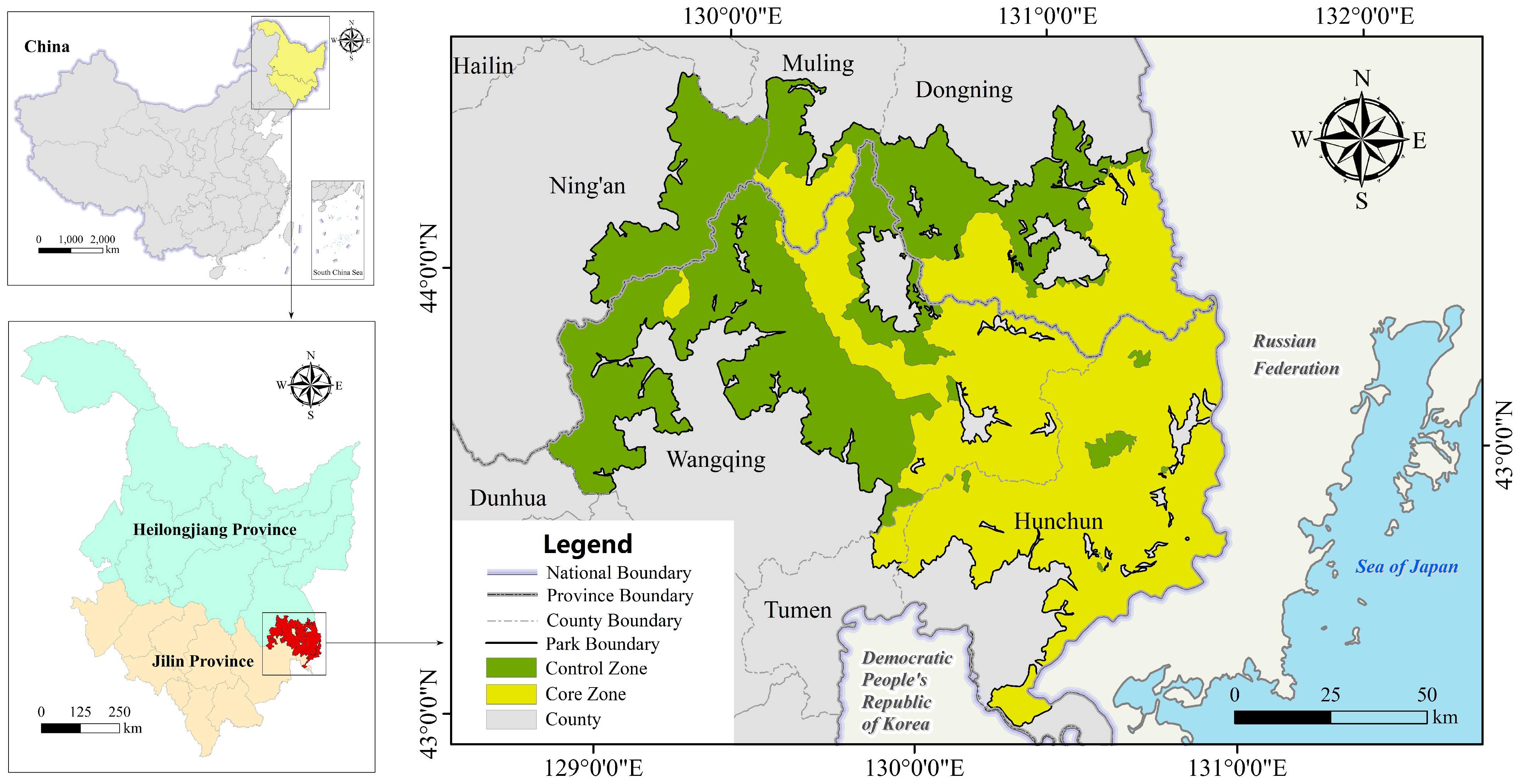

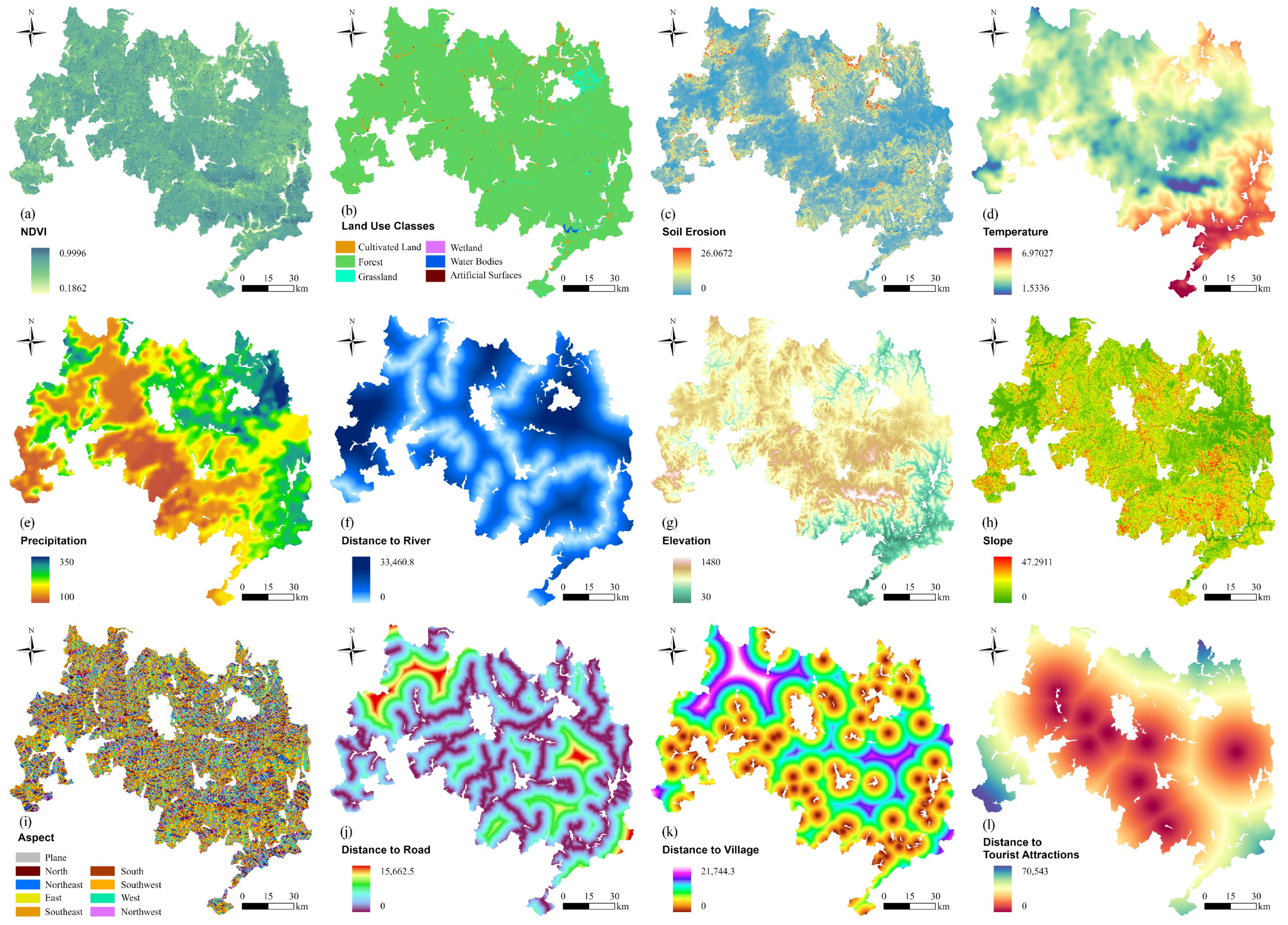




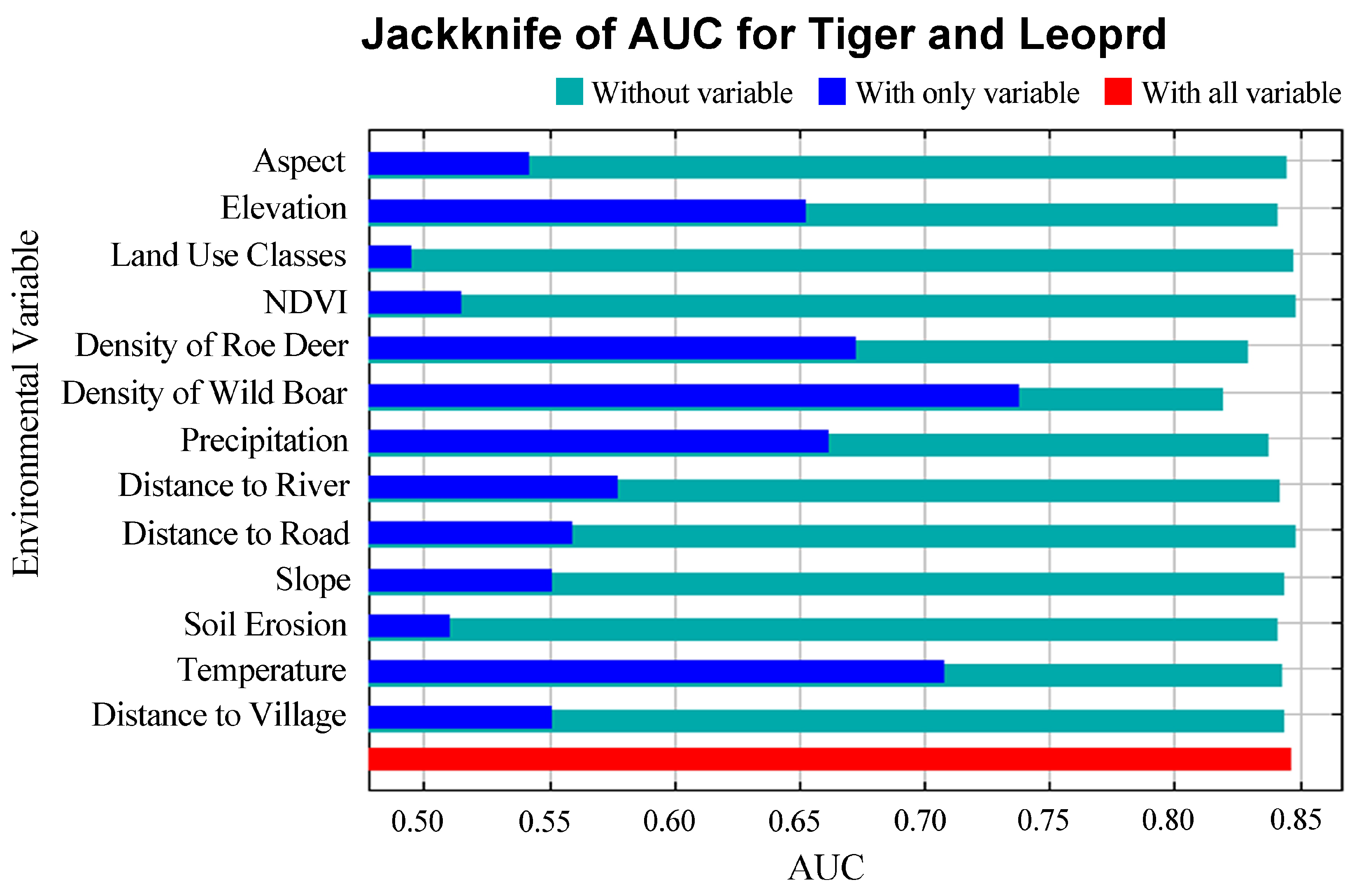
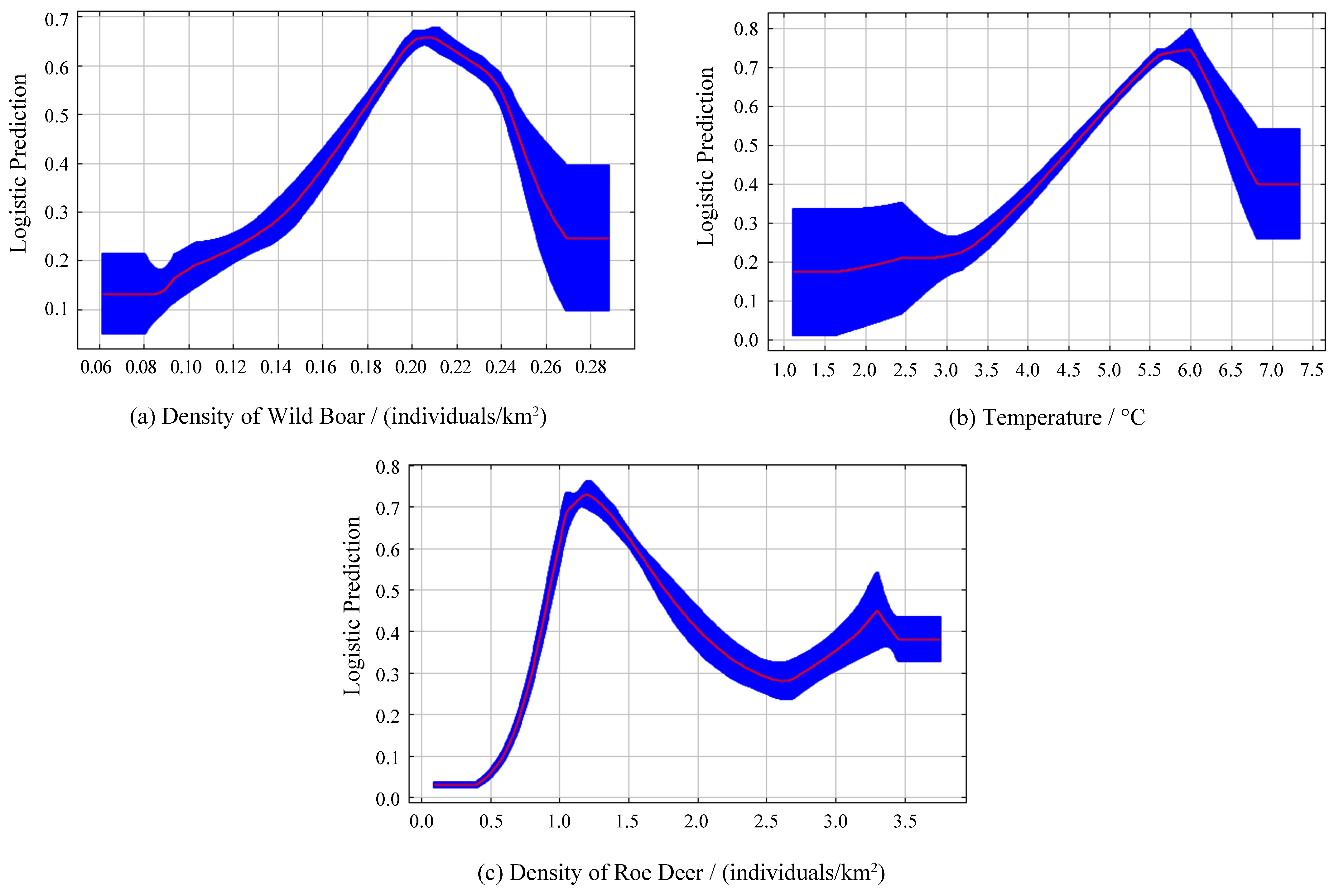
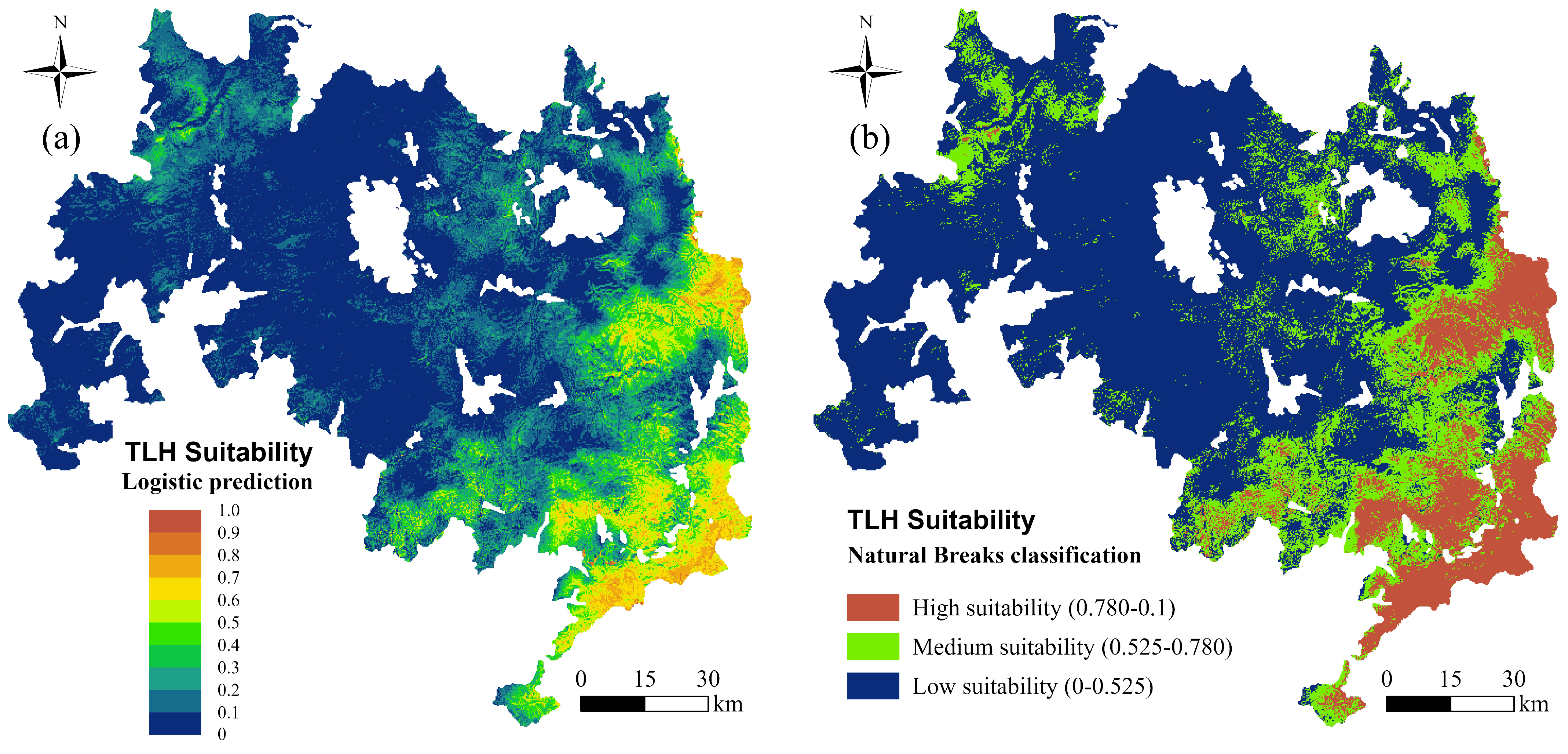
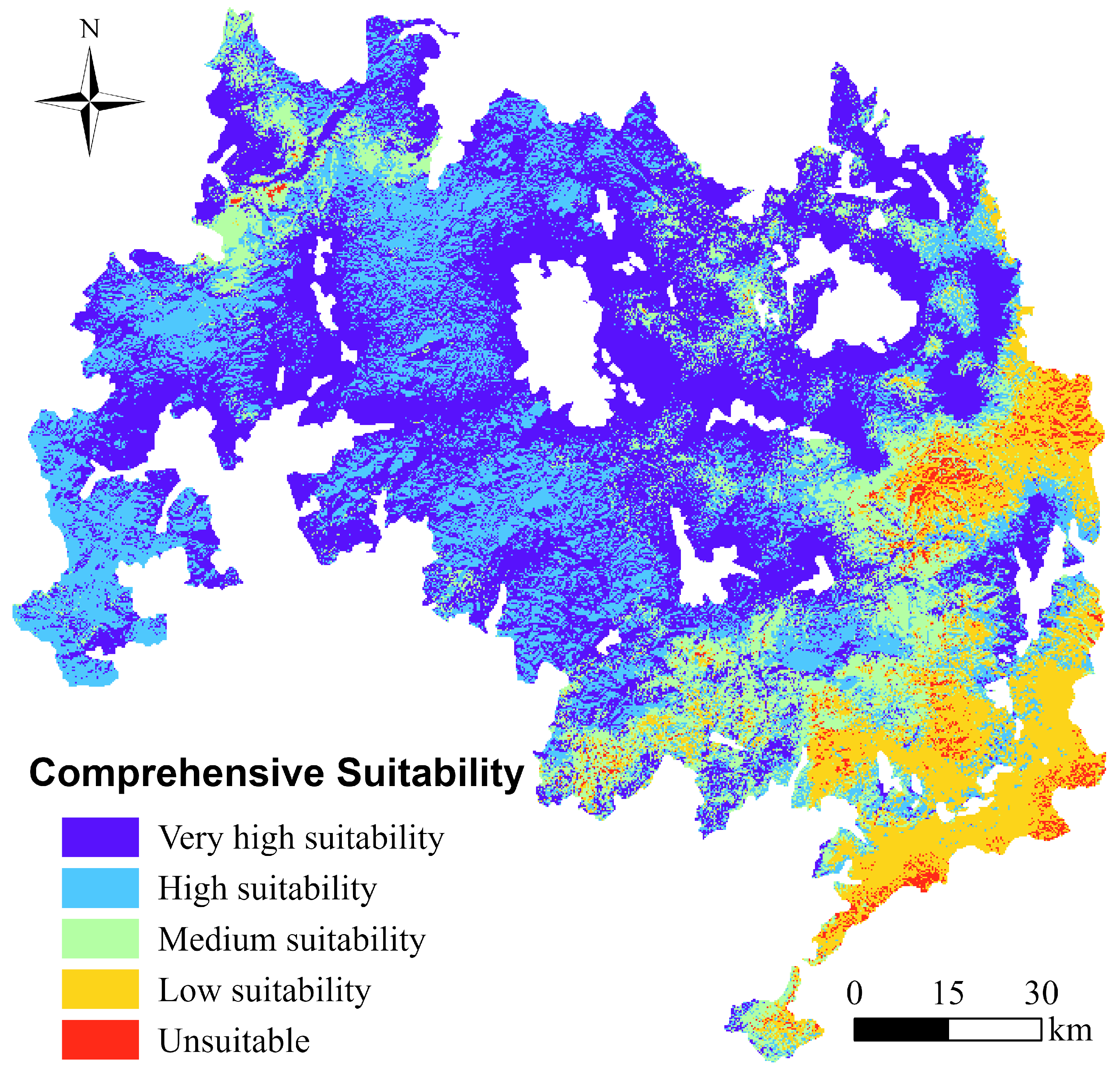
| Factors | Criteria | Description | Positive (+) or Negative (−) |
|---|---|---|---|
| Environmental factors (Aa) | NDVI (Aa1) | Indicates the density and health of vegetation. | + |
| Land Use Classes (Aa2) | Describes the type of land cover. | User-defined * | |
| Soil Erosion (Aa3)/(t/(ha·y)) | Higher erosion areas are more sensitive to tourism. | − | |
| Temperature (Aa4)/°C | Affects the comfort and seasonality of tourist activities. | + | |
| Precipitation (Aa5)/mm | Higher rainfall levels facilitate vegetation development. | + | |
| Distance to Rivers (Aa6)/m | Proximity to rivers enhances a location’s attractiveness through water-based activities and scenic value. | − | |
| Topography factors (Ab) | Elevation (Ab1)/m | Lower elevations are more accessible. | − |
| Slope (Ab2)/° | Steeper slopes decrease tourism safety. | − | |
| Aspect (Ab3) | Plants on sun-facing slopes generally grow better. | User-defined * | |
| Tourism development factors (Ac) | Distance to Roads (Ac1)/m | Closer proximity to roads increases accessibility. | − |
| Distance to Villages (Ac2)/m | Proximity to local communities enhances cultural experiences and support services for ecotourism. | − | |
| Distance to Tourist Attractions (Ac3)/m | Closer proximity to existing attractions benefits tourism development. | − |
| Factors | Criteria | Description |
|---|---|---|
| Environmental factors (Ba) | NDVI (Ba1) | Higher NDVI values suggest denser vegetation. |
| Land Use Classes (Ba2) | Identifies the types of land use. | |
| Soil Erosion (Ba3)/(t/(ha·y)) | Indicates the rate of soil loss, impacting the vegetation and water quality that is crucial for wildlife. | |
| Temperature (Ba4)/°C | Affects the species’ range and behavior. | |
| Precipitation (Ba5)/mm | Adequate rainfall supports lush vegetation. | |
| Distance to Rivers (Ba6)/m | Proximity to rivers offers vital water resources and fosters diverse vegetation. | |
| Topography factors (Bb) | Elevation (Bb1)/m | Affects climate, vegetation type, and prey availability. |
| Slope (Bb2)/° | Steeper slopes may limit accessibility for both the predators and their prey. | |
| Aspect (Bb3) | Determines sunlight exposure, shaping prey distribution for tigers and leopards. | |
| Human disturbance factors (Bc) | Distance to Roads (Bc1)/m | Roads increase human disturbance. |
| Distance to Villages (Bc2)/m | Villages can increase human–wildlife conflicts and disturbance. | |
| Prey species factors (Bd) | Density of Wild Boars (Bd1)/(individuals/km2) | Wild boar are primary prey for tigers and leopards. |
| Density of Roe Deer (Bd2)/(individuals/km2) | Roe deer are essential prey for tigers and leopards. |
| Criteria | Source | Link * | Resolution |
|---|---|---|---|
| NDVI | NASA’s Earthdata Search (2022) | ladsweb.modaps.eosdis.nasa.gov | 30 m |
| Land Use Classes | Globeland30 (2020) | www.webmap.cn/mapDataAction.do?method=globalLandCover | 30 m |
| Soil Erosion | China Science Data Bank (2020) | www.scidb.cn | 250 m |
| Temperature | National Earth System Science Data Center (2022) | www.geodata.cn | 1000 m |
| Precipitation | National Earth System Science Data Center (2022) | www.geodata.cn | 1000 m |
| Distance to Rivers | China’s 1:1,000,000 Basic Geographic Information Data (2015) | www.webmap.cn | 100 m |
| Elevation | Copernicus DEM GLO30 (2015) | panda.copernicus.eu/panda | 30 m |
| Slope | Copernicus DEM GLO30 (2015) | panda.copernicus.eu/panda | 30 m |
| Aspect | Copernicus DEM GLO30 (2015) | panda.copernicus.eu/panda | 30 m |
| Distance to Roads | Gaode Map (2020) | www.amap.com | 100 m |
| Distance to Villages | National Bureau of Statistics of China (2020) | www.stats.gov.cn | 100 m |
| Distance to Tourist Attractions | NCTLNP Administration (2020) | Local dataset | 250 m |
| Density of Wild Boars | NCTLNP Administration (2020) | Local dataset | 250 m |
| Density of Roe Deer | NCTLNP Administration (2020) | Local dataset | 250 m |
| Tiger and Leopard Track Sites | NCTLNP Administration (2020) | Local dataset | 250 m |
| Criteria | Weight | Rank | Mean | Standard Deviation (SD) | Coefficient of Variation (CV) * (%) |
|---|---|---|---|---|---|
| NDVI (Aa1) | 0.0011 | 12 | 0.9322 | 0.0297 | 3.19 |
| Land Use Classes (Aa2) | 0.0181 | 10 | 0.9740 | 0.1302 | 13.36 |
| Soil Erosion (Aa3) | 0.0126 | 11 | 0.9379 | 0.0681 | 7.26 |
| Temperature (Aa4) | 0.0813 | 4 | 0.4455 | 0.1447 | 32.48 |
| Precipitation (Aa5) | 0.2603 | 1 | 0.3730 | 0.2031 | 54.47 |
| Distance to Rivers (Aa6) | 0.0600 | 7 | 0.7584 | 0.1786 | 23.55 |
| Elevation (Ab1) | 0.0367 | 9 | 0.5908 | 0.1286 | 21.76 |
| Slope (Ab2) | 0.0454 | 8 | 0.7306 | 0.1516 | 20.75 |
| Aspect (Ab3) | 0.2323 | 2 | 0.5486 | 0.2772 | 50.53 |
| Distance to Roads (Ac1) | 0.0775 | 6 | 0.7496 | 0.1973 | 26.32 |
| Distance to Villages (Ac2) | 0.0811 | 5 | 0.6619 | 0.1858 | 28.07 |
| Distance to Tourist Attractions (Ac3) | 0.0935 | 3 | 0.6686 | 0.2014 | 30.13 |
| Ecotourism Suitability Map Class | Area/km2 | Proportion/% |
|---|---|---|
| High suitability | 3765.313 | 27.08 |
| Medium suitability | 6103.625 | 43.90 |
| Low suitability | 4034.875 | 29.02 |
| Variable | Percent Contribution/% | Variable | Percent Contribution/% |
|---|---|---|---|
| Density of Wild Boars | 29.3 | Aspect | 4.5 |
| Temperature | 18.6 | Distance to Road | 4.2 |
| Density of Roe Deer | 12 | Slope | 3.9 |
| Soil Erosion | 6.1 | Elevation | 2.3 |
| Precipitation | 5.5 | Land Use Classes | 2.1 |
| Distance to Rivers | 5 | NDVI | 1.8 |
| Distance to Villages | 4.8 |
| TLH Suitability Map Class | Area/km2 | Proportion/% |
|---|---|---|
| High suitability | 1716.688 | 12.73 |
| Medium suitability | 2718.688 | 20.15 |
| Low suitability | 9053.750 | 67.12 |
| Comprehensive Suitability Map Class | Area/km2 | Proportion/% |
|---|---|---|
| Very high suitability | 6152.563 | 45.62 |
| High suitability | 3806.500 | 28.23 |
| Medium suitability | 1811.313 | 13.43 |
| Low suitability | 1487.813 | 11.03 |
| Unsuitable | 228.063 | 1.69 |
Disclaimer/Publisher’s Note: The statements, opinions and data contained in all publications are solely those of the individual author(s) and contributor(s) and not of MDPI and/or the editor(s). MDPI and/or the editor(s) disclaim responsibility for any injury to people or property resulting from any ideas, methods, instructions or products referred to in the content. |
© 2024 by the authors. Licensee MDPI, Basel, Switzerland. This article is an open access article distributed under the terms and conditions of the Creative Commons Attribution (CC BY) license (https://creativecommons.org/licenses/by/4.0/).
Share and Cite
Quan, Q.; Wu, Y. Integrating Entropy Weight and MaxEnt Models for Ecotourism Suitability Assessment in Northeast China Tiger and Leopard National Park. Land 2024, 13, 1269. https://doi.org/10.3390/land13081269
Quan Q, Wu Y. Integrating Entropy Weight and MaxEnt Models for Ecotourism Suitability Assessment in Northeast China Tiger and Leopard National Park. Land. 2024; 13(8):1269. https://doi.org/10.3390/land13081269
Chicago/Turabian StyleQuan, Qianhong, and Yijin Wu. 2024. "Integrating Entropy Weight and MaxEnt Models for Ecotourism Suitability Assessment in Northeast China Tiger and Leopard National Park" Land 13, no. 8: 1269. https://doi.org/10.3390/land13081269





